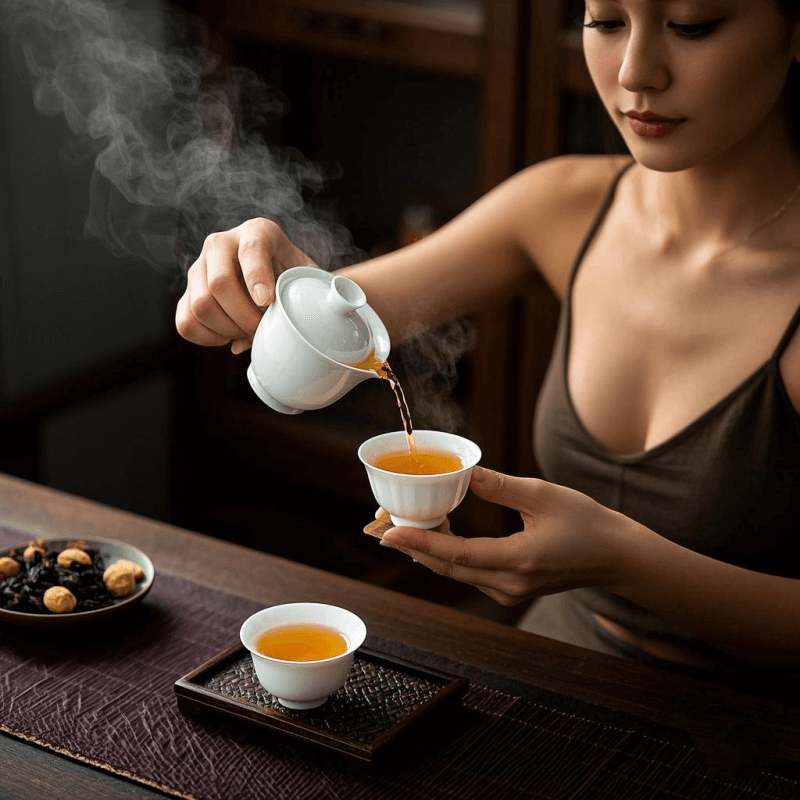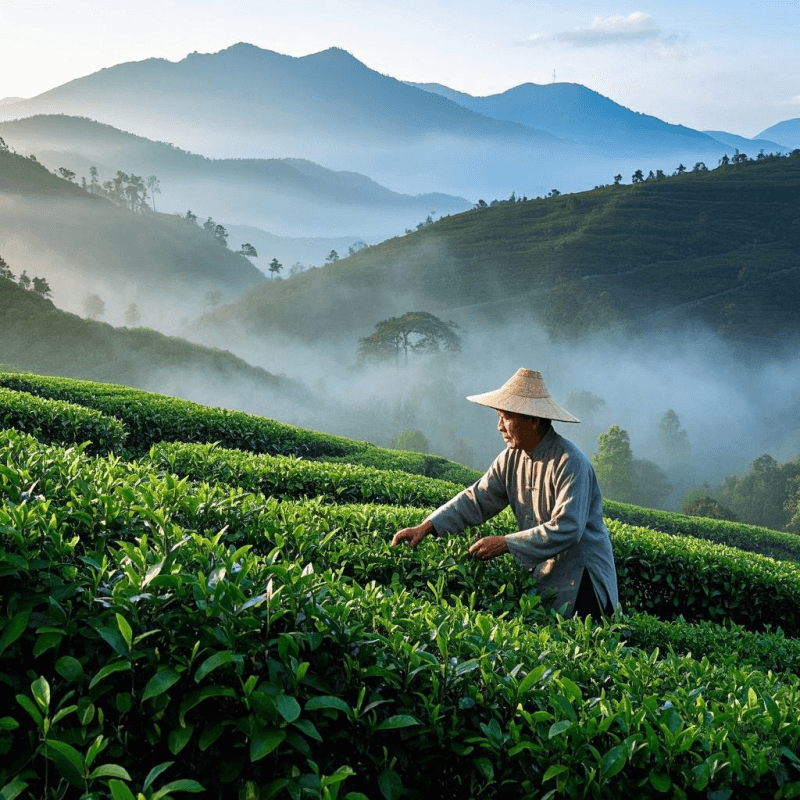1. Introduction: Why Phoenix Oolong Tea Deserves Your Attention

In the vast world of oolong tea, few varieties carry the mystique and depth of phoenix oolong tea. Hailing from China’s mist-shrouded Phoenix Mountains, this single-origin gem—known locally as dancong (single bush)—is more than a beverage; it’s a sip of history, terroir, and centuries of craftsmanship. What sets it apart? Its ability to capture the “mountain soul” of its homeland, with flavors as diverse as the wildflowers that dot its growing slopes.
Awarded “China’s Most Distinctive Oolong” at the 2023 International Tea Expo, phoenix oolong tea has gained global acclaim for its unparalleled aroma complexity. Tea connoisseurs often describe it as “a botanical symphony in a cup,” where each sip reveals new layers. For tea lovers seeking complexity beyond basic blends, phoenix oolong tea offers an unforgettable journey into China’s rich tea heritage—a journey that begins with understanding its unique origins.
2. What Is Phoenix Oolong Tea (Dancong)? A Story of Origin
Phoenix oolong tea, or Fenghuang Dancong in Chinese, translates to “Phoenix Single Bush”—a name that hints at its unique cultivation. Unlike mass-produced teas, each batch of authentic phoenix oolong tea comes from individual, ancient tea bushes grown in Guangdong Province’s Phoenix Mountains (Fenghuang Shan), some dating back over 1,200 years. The oldest surviving bush, nicknamed “The Phoenix Elder,” stands 5.8 meters tall and produces just 2–3 kilograms of tea annually, making its leaves a rare treasure.
These bushes thrive in a rugged landscape of red clay soil rich in iron and minerals, high altitude (600–1,200 meters), and frequent mist that shrouds the mountains 200+ days a year. Such conditions force the plants to develop deep roots—some reaching 3 meters—to access nutrients, concentrating flavor compounds in their leaves. For generations, local farmers have tended these bushes using techniques unchanged for centuries: handpicking leaves at dawn when moisture levels hover around 70%, ensuring each harvest preserves the bush’s distinct character.
“Phoenix oolong tea is a testament to terroir—each bush tells a story of its specific mountain microclimate,” notes TeaVivre, a leading authority on Chinese teas. This focus on single-bush identity makes every phoenix oolong tea a unique expression of its environment.
3. The Unique Aromas and Craft of Dancong Oolong
What makes phoenix oolong tea a sensory marvel? Its extraordinary range of natural aromas and meticulous processing that transforms fresh leaves into liquid art. Unlike flavored teas, its scents—from honey and orchid to lychee and almond—emerge naturally from the tea bush itself, shaped by soil composition, altitude, and seasonal rainfall patterns.
🌸 Aroma Profiles: Nature’s Palette
Phoenix oolong boasts over 80 recorded aroma types, classified by local tea masters into six primary categories. Standout varieties include:
- Honey Orchid: Dominated by sweet osmanthus-like florals with a honeyed finish, the most iconic and widely loved profile.
- Lychee: Bright, tropical aroma mimicking fresh lychee flesh, with crisp, juicy undertones—harvested from bushes near lychee orchards.
- Almond: Nutty, warm, with a buttery creaminess, derived from ancient bushes growing in calcium-rich soil.
- Cinnamon: Spicy, woody notes with a hint of dried fruit, rare and prized for its winter-appropriate warmth.
👨🌾 Traditional Processing Steps
Crafting phoenix oolong tea is an art passed down through families, with each step requiring precision timing and intuition:
- Withering: Leaves dry in bamboo trays under shaded mountain breezes for 4–6 hours, reducing moisture from 75% to 60% to activate enzymes.
- Tossing: Gentle shaking in woven baskets (10–15 minutes) bruises leaf edges, triggering oxidation and releasing aromatic oils.
- Oxidation: Leaves rest on bamboo mats in temperature-controlled rooms (22–25°C) for 2–4 hours, with masters checking color hourly—phoenix oolong typically oxidizes 20–40%.
- Fixing: Brief pan-frying at 200°C stops oxidation, locking in aromas while preserving enzymes that enhance flavor.
- Rolling: Leaves are hand-rolled into tight strips to release more oils, then shaped into twists that unfurl during brewing.
- Drying: Slow roasting over pine wood fires (60–70°C) for 2–3 hours removes final moisture, adding subtle smoky depth.
This labor-intensive process, often taking 12+ hours per batch, ensures every cup of phoenix oolong tea carries the essence of its mountain origins.
4. Decoding the Flavor: Mountain Rhyme and Floral Elegance
The magic of phoenix oolong tea lies in its “mountain rhyme” (shan yun)—a term describing the mineral-rich, earthy depth that lingers after the initial sip. This unique quality stems from the Phoenix Mountains’ granite-rich soil, which infuses the tea with trace minerals like potassium and magnesium, balancing its bright aromas with subtle complexity.
👅 Taste Breakdown
- First Sip: Fresh, vibrant—think blooming flowers (orchid, osmanthus) or ripe fruit (lychee, apricot), depending on the variety. The initial burst is clean and immediate, 唤醒 the palate.
- Mid-Palate: Creamy umami emerges, softening the brightness with a silky texture that coats the tongue. This richness comes from amino acids like theanine, concentrated in slow-grown mountain leaves.
- Finish: The “mountain rhyme” takes hold—a clean, mineral-rich linger with a gentle sweetness that invites another sip. This lingering effect is what tea masters call “hui gan” (returning sweetness).
Lightly oxidized versions (20–30%) lean floral and crisp, with higher levels of catechins that contribute freshness. More oxidized batches (30–40%) offer richer, fruitier profiles, as oxidation converts catechins into mellow theaflavins. Either way, phoenix oolong tea avoids bitterness, making it approachable yet sophisticated enough for connoisseurs.
5. How to Brew Phoenix Oolong Tea for Maximum Flavor

To unlock the full potential of phoenix oolong tea, brewing matters as much as the tea itself. Follow these steps to honor its complexity and experience its full aroma spectrum:
🍵 Tools You’ll Need
- A small Yixing clay teapot (100–150ml) is ideal—its porous surface absorbs and enhances flavors over time, creating a personalized brewing vessel.
- A gaiwan (lidded cup) for precise infusion control, perfect for observing leaf unfurling.
- A thermometer to monitor water temperature, critical for preserving delicate aromas.
- Spring or filtered water with a mineral content of 50–100 TDS (total dissolved solids)—too many minerals overpower the tea; too few flatten its flavor.
🌡️ Brewing Steps
- Prep: Warm your teapot/gaiwan with hot water, swirling to ensure even heating—this prevents temperature drops when adding leaves.
- Leaf Ratio: Use 5–7 grams of phoenix oolong tea per 4 oz (120ml) water. This tea thrives on generosity; skimping dulls its complexity.
- Water Temperature: 195–205°F (90–96°C). For floral varieties like Honey Orchid, lean toward 195°F to preserve delicate notes; for richer profiles like Almond, 205°F extracts deeper flavors.
- Steep Time:
- First steep: 15–20 seconds (washes leaves, awakens dormant aromas).
- Second steep: 25–30 seconds (first full flavor infusion—expect bright florals/fruit).
- Third to fifth steeps: 45 seconds to 1 minute (mountain rhyme deepens, umami emerges).
- Subsequent steeps: Add 10–15 seconds each time. Phoenix oolong tea can steep 8–12 times, with later infusions revealing mineral-driven depth.
Brew Phoenix Oolong Tea the traditional way with our artisanal teaware to elevate this ritual—clay vessels enhance its mountain-driven flavors beautifully, while glass gaiwans let you watch leaves unfurl like tiny dancers.
6. The Phoenix Mountains: Where Tea Meets Soul
The Phoenix Mountains aren’t just a backdrop—they’re the living heart of phoenix oolong tea. Stretching across Guangdong’s Chaozhou region, this 200-square-kilometer range is a UNESCO-recognized biodiversity hotspot, home to over 1,200 plant species and 300+ animal species that contribute to its unique ecosystem.
Local legend claims the mountains were once home to phoenixes, celestial birds whose feathers fell to the ground and sprouted into the first tea bushes. While mythical, this story reflects the region’s reverence for tea as a gift from nature. Geologically, the range’s granite bedrock, formed over 100 million years, breaks down into soil rich in quartz and feldspar, creating the perfect foundation for tea growth. Annual rainfall averages 1,800mm, with mist clinging to slopes until mid-morning, slowing leaf growth and concentrating nutrients.
Today, the mountains are a protected tea-growing region, with farmers practicing organic cultivation that avoids pesticides and synthetic fertilizers. “We don’t just grow tea—we nurture a relationship with the land,” says sixth-generation tea farmer Chen Mei. “The bushes give us flavor; we give them care, letting native insects control pests and using tea seed oil cake as natural fertilizer.” This harmony between humans and nature is what gives phoenix oolong tea its “mountain soul.”
7. Conclusion: Make Phoenix Oolong Tea Part of Your Daily Ritual
Phoenix oolong tea is more than a drink—it’s a connection to place, tradition, and the quiet magic of nature. Its ability to transform ordinary moments into sensory escapes—whether a morning pause, afternoon pick-me-up, or evening unwind—makes it a treasure for tea lovers.
From its honeyed florals to its lingering mountain rhyme, every cup of phoenix oolong tea tells a story: of ancient bushes rooted deep in rocky soil, of farmers who rise at dawn to harvest, of a mountain range that breathes life into every leaf. Whether you’re new to oolong tea or a seasoned connoisseur, this dancong variety invites you to slow down, savor, and taste the soul of its mountain home.
Explore our Phoenix Oolong Tea collection for true dancong flavor and let each sip transport you to China’s misty peaks. As local tea proverb says, “A cup of Phoenix oolong is a walk in the mountains”—and in today’s busy world, that’s a journey we all need.
Discover phoenix oolong tea—China’s dancong gem. Explore its mountain-driven flavors, 80+ natural aromas, and why dancong oolong tea captures the soul of the Phoenix Mountains. Taste the difference!

Pingback: Dan Cong Oolong Tea: Unlock Its Unique Aroma & Why It’s a Tea Gem